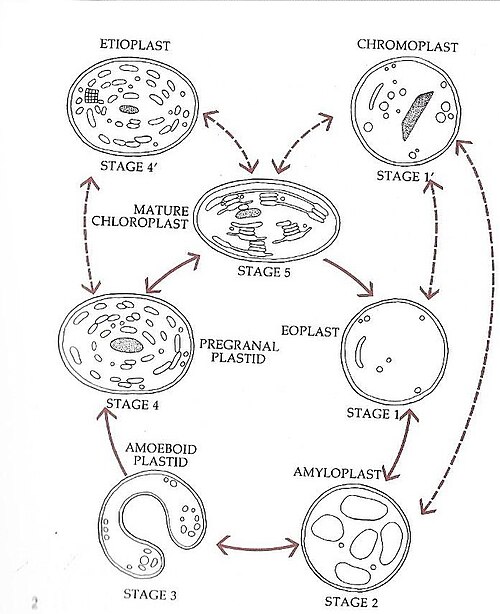Plastidnoun
(cytology) Any of various organelles found in the cells of plants and algae, often concerned with photosynthesis
Plastidnoun
A formative particle of albuminous matter; a monad; a cytode. See the Note under Morphon.
Plastidnoun
any of several types of minute granules found in the protoplasm of vegetable cells, having their own membrane, robosomes, and DNA. Among plant cells the most common are chloroplasts, which contain the chlorophyll and the photosynthetic machinery of the cell. They are divided by their colors into three classes, chloroplastids, chromoplastids, and leucoplastids.
Plastidnoun
any of various small particles in the cytoplasm of the cells of plants and some animals containing pigments or starch or oil or protein
Plastid
The plastid (Greek: πλαστός; plastós: formed, molded – plural plastids) is a membrane-bound organelle found in the cells of plants, algae, and some other eukaryotic organisms. They are considered to be intracellular endosymbiotic Cyanobacteria.
Chloroplastnoun
(cytology) An organelle found in the cells of green plants, and in photosynthetic algae, where photosynthesis takes place.
Chloroplastnoun
A plastid containing chlorophyll, developed only in cells exposed to the light. Chloroplasts are minute flattened granules, usually occurring in great numbers in the cytoplasm near the cell wall, and consist of a colorless ground substance saturated with chlorophyll pigments. Under light of varying intensity they exhibit phototactic movements. In animals chloroplasts occur only in certain low forms.
Chloroplastnoun
plastid containing chlorophyll and other pigments; in plants that carry out photosynthesis
Chloroplast
Chloroplasts are organelles that conduct photosynthesis, where the photosynthetic pigment chlorophyll captures the energy from sunlight, converts it, and stores it in the energy-storage molecules ATP and NADPH while freeing oxygen from water in plant and algal cells. They then use the ATP and NADPH to make organic molecules from carbon dioxide in a process known as the Calvin cycle.




